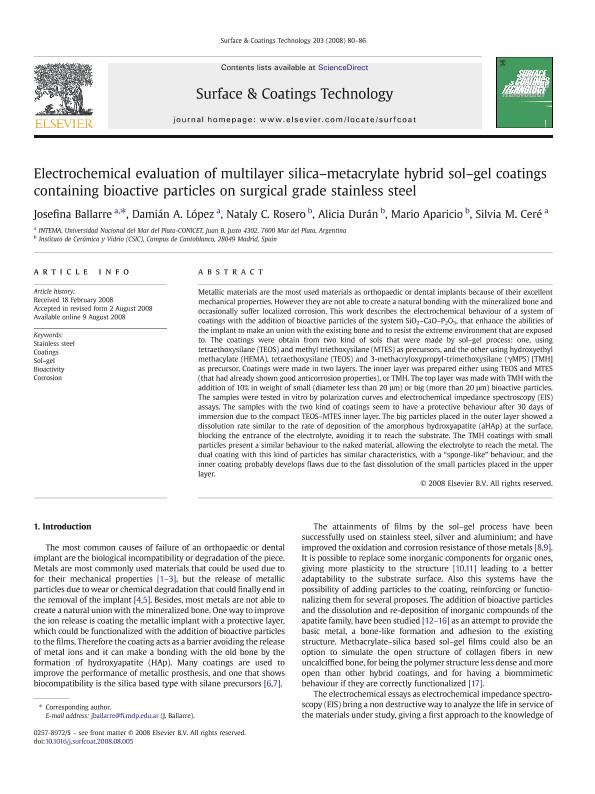Artículo
Electrochemical evaluation of multilayer silica-metacrylate hybrid sol-gel coatings containing bioactive particles on surgical grade stainless steel
Ballarre, Josefina ; López, Damián A.; Rosero, Nataly C.; Durán, Alicia; Aparicio, Mario; Ceré, Silvia
; López, Damián A.; Rosero, Nataly C.; Durán, Alicia; Aparicio, Mario; Ceré, Silvia
 ; López, Damián A.; Rosero, Nataly C.; Durán, Alicia; Aparicio, Mario; Ceré, Silvia
; López, Damián A.; Rosero, Nataly C.; Durán, Alicia; Aparicio, Mario; Ceré, Silvia
Fecha de publicación:
11/2008
Editorial:
Elsevier Science Sa
Revista:
Surface and Coatings Technology
ISSN:
0257-8972
Idioma:
Inglés
Tipo de recurso:
Artículo publicado
Clasificación temática:
Resumen
Metallic materials are the most used materials as orthopaedic or dental implants because of their excellent mechanical properties. However they are not able to create a natural bonding with the mineralized bone and occasionally suffer localized corrosion. This work describes the electrochemical behaviour of a system of coatings with the addition of bioactive particles of the system SiO2-CaO-P2 O5, that enhance the abilities of the implant to make an union with the existing bone and to resist the extreme environment that are exposed to. The coatings were obtain from two kind of sols that were made by sol-gel process: one, using tetraethoxysilane (TEOS) and methyl triethoxysilane (MTES) as precursors, and the other using hydroxyethyl methacylate (HEMA), tetraethoxysilane (TEOS) and 3-methacryloxypropyl-trimethoxysilane (γMPS) [TMH] as precursor. Coatings were made in two layers. The inner layer was prepared either using TEOS and MTES (that had already shown good anticorrosion properties), or TMH. The top layer was made with TMH with the addition of 10% in weight of small (diameter less than 20 μm) or big (more than 20 μm) bioactive particles. The samples were tested in vitro by polarization curves and electrochemical impedance spectroscopy (EIS) assays. The samples with the two kind of coatings seem to have a protective behaviour after 30 days of immersion due to the compact TEOS-MTES inner layer. The big particles placed in the outer layer showed a dissolution rate similar to the rate of deposition of the amorphous hydroxyapatite (aHAp) at the surface, blocking the entrance of the electrolyte, avoiding it to reach the substrate. The TMH coatings with small particles present a similar behaviour to the naked material, allowing the electrolyte to reach the metal. The dual coating with this kind of particles has similar characteristics, with a "sponge-like" behaviour, and the inner coating probably develops flaws due to the fast dissolution of the small particles placed in the upper layer. © 2008 Elsevier B.V. All rights reserved.
Palabras clave:
Bioactivity
,
Coatings
,
Corrosion
,
Sol-Gel
,
Stainless Steel
Archivos asociados
Licencia
Identificadores
Colecciones
Articulos(INTEMA)
Articulos de INST.DE INV.EN CIENCIA Y TECNOL.MATERIALES (I)
Articulos de INST.DE INV.EN CIENCIA Y TECNOL.MATERIALES (I)
Citación
Ballarre, Josefina; López, Damián A.; Rosero, Nataly C.; Durán, Alicia; Aparicio, Mario; et al.; Electrochemical evaluation of multilayer silica-metacrylate hybrid sol-gel coatings containing bioactive particles on surgical grade stainless steel; Elsevier Science Sa; Surface and Coatings Technology; 203; 1-2; 11-2008; 80-86
Compartir
Altmétricas



